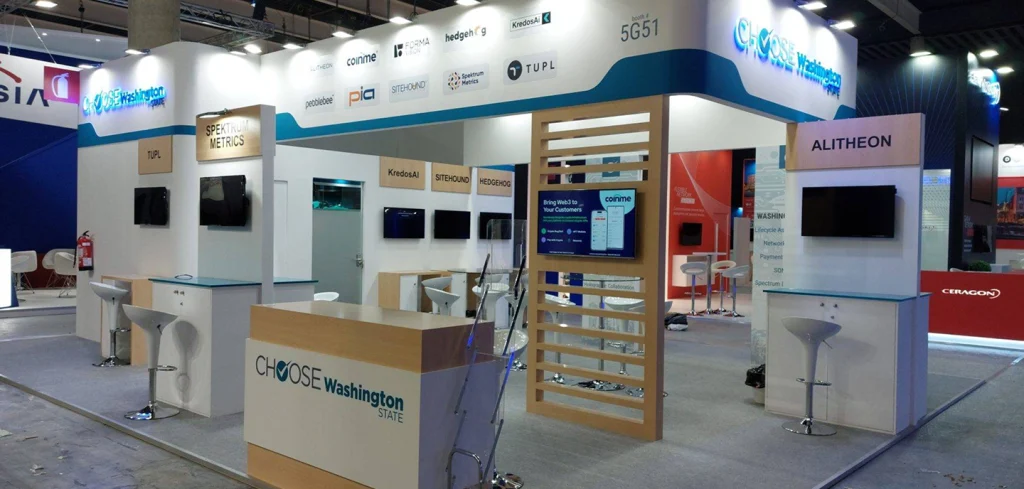
Introduction:
Trade show exhibits are pivotal moments for businesses to showcase their products, connect with potential customers, and make lasting impressions. However, the environmental impact of trade show booths can be significant, from the materials used in construction to the energy consumed during the event.
In response to growing concerns about sustainability, businesses are rethinking how they approach trade show booth design and construction. In this blog, we’ll explore strategies for reducing waste, reusing materials, and reimagining the life cycle of trade show booths to minimize environmental impact and maximize value.
Reducing Waste:
The first step in extending the life cycle of your trade show booth is to minimize waste during construction and use. Opt for lightweight, durable materials that can be easily transported and assembled, reducing the need for excessive packaging and logistical resources. Additionally, consider modular designs that can be customized and reconfigured for different events, eliminating the need for new booths for each show. By prioritizing efficiency and resourcefulness in booth design, businesses can significantly reduce their environmental footprint while saving time and money in the long run.
When selecting materials for your booth, consider options that are not only durable but also environmentally friendly. Recycled materials, such as recycled cardboard or plastic, can be excellent choices as they reduce the demand for new resources and divert waste from landfills. Furthermore, choose materials that can be easily recycled or composted at the end of their life cycle to minimize environmental impact.
Reusing Materials:
Another key strategy for extending the life cycle of trade show booths is to embrace the concept of reuse. Instead of discarding booths after a single use, explore opportunities to repurpose and refurbish existing materials for future events. This could involve updating graphics, replacing worn components, or incorporating new elements to give the booth a fresh look and feel. Additionally, consider renting or leasing booth components for events where a full-scale booth may not be necessary, further extending the lifespan of materials and reducing waste.
Repurposing materials not only reduces waste but also saves resources and energy associated with manufacturing new materials. When refurbishing your booth, prioritize reusable components such as modular displays, furniture, and signage. By investing in high-quality, durable materials upfront, you can ensure that your booth remains functional and visually appealing for multiple events, maximizing its lifespan and minimizing environmental impact.
Reimagining Design Concepts:
- Innovative thinking is essential for reimagining the life cycle of trade show booths and finding creative solutions to sustainability challenges. Consider unconventional materials and design concepts that prioritize sustainability without compromising functionality or aesthetics.
- Explore the potential of digital technologies, such as virtual and augmented reality, to create immersive experiences that engage attendees while minimizing physical waste. By thinking outside the box and embracing new approaches to booth design, businesses can transform trade show exhibits into showcases of innovation and environmental responsibility.
- When reimagining your booth design, consider incorporating elements that highlight your commitment to sustainability and environmental stewardship. Showcase eco-friendly materials and practices throughout your booth, such as energy-efficient lighting, water-saving fixtures, and biodegradable signage.
- Additionally, use your booth as an opportunity to educate attendees about sustainability issues and promote environmentally conscious behaviors. By incorporating sustainability into your booth design, you can not only reduce your environmental impact but also inspire others to take action and make a positive difference.
Conclusion:
In conclusion, extending the life cycle of trade show booths requires a commitment to reducing waste, reusing materials, and reimagining design concepts. By embracing modular designs, repurposing existing materials, and exploring innovative solutions, businesses can minimize their environmental impact while maximizing the value of their trade show investments.
As sustainability becomes an increasingly important consideration for businesses and consumers alike, adopting eco-friendly practices in trade show booth design is not only a responsible choice but also a strategic one. By leading the way in sustainable trade show practices, businesses can demonstrate their commitment to environmental stewardship while enhancing their brand reputation and driving positive change in the industry.


 Global
Global USA
USA

